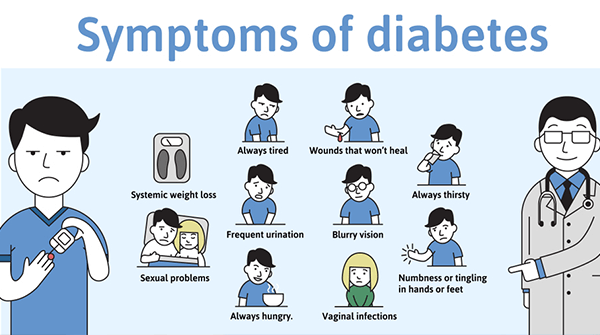Diabetes is a chronic disease that is associated with uncharacteristically high levels of glucose in the blood. Absence or inadequate production of insulin (produced by the pancreas) that lowers blood sugar level causes diabetes. Diabetes may also be caused by the body’s incapability to utilize the produced insulin. There are two widely know kinds of diabetes: – Type 1 or insulin-dependent diabetes or juvenile-onset diabetes – Type 2 or non-insulin-dependent diabetes or adult-onset diabetes Diabetes can cause obesity and hypertension. It reduced the level of HDL or good cholesterol in the blood and elevates the production of triglycerides which are harmful to one’s health. Moreover, it can instigate a long line of generations of diabetes patients in a family. If you feel that you have pre-diabetes or that you are showing diabetes symptoms early signs, you should consult a doctor immediately. We have created a list of the 9 early diabetes signs for a quick pre-diagnosis.
Here are the nine early signs of Diabetes:
- Frequent urination: Frequent urination can be a sign of diabetes onset. When the glucose levels are high in your blood, the kidney tries to remove the excess by filtering it which results in urination. This will make the patient urinate more, especially at night.
- Increased level of thirst:
Increased level of thirst is also considered to be a sign of diabetes. While frequent urination helps in removing excess sugar from the blood it can also cause water loss. When the body loses the necessary amount of water, it can cause dehydration and make an individual feel more thirsty than usual.
- Increased hunger:
Increased hunger is another early warning sign of diabetes. In usual cases, our digestive system is responsible for breaking down the food we consume into glucose (which is a simple sugar unit) so that it can easily move from the bloodstream to the cells. However, in diabetic cases, a sufficient amount of glucose does not move to the cell. Therefore, the patient does not receive enough energy from the food that they eat. Thus, it leads to them feeling constantly hungry even after having recently eaten.
- Feeling of fatigue:
The feeling of fatigue is something that follows diabetes patients. Diabetes can have an adverse effect on the patient’s energy level causing them to feel extremely tired after small amounts of work. This again happens because a sufficient amount of glucose does not move from the bloodstream to the cells.
- Blurred vision:
Blurred vision is another sign of diabetes. Diabetes can be extremely dangerous for the vision. An elevated blood sugar level can damage the blood vessels in the eyes leading to blurred vision. This problem can be recurrent. While this may come and go, the damage can become severe if it is left untreated for a long period of time. There is a possibility that this may eventually lead to permanent loss of sight.
- Slow healing of wounds:
Slow healing of cuts is a common symptom of diabetes. The high sugar level in blood can reduce the body’s capability to heal wounds and cuts speedily. This happens because the excess amounts of glucose in the bloodstream can damage the nerves and blood vessels which in turn affect the blood circulation. Therefore, even the tiniest wounds can take weeks or even months to heal. The danger of infection also increases with slow healing.
- Numbness or pain in arms and feet
Numbness or pain in arms and feet can act as a symptom of diabetes. The excess amounts of glucose in the bloodstream can damage the nerves and blood vessels which in turn affect the blood circulation. This can lead to pain in arms and feet or a tingling sensation with numbness like pins and needles. This condition is widely known as neuropathy and needs to be treated immediately. If the condition worsens, it can lead to further complications.
- Patchy skin:
Dark patches of skin can be a sign of diabetes. This usually happens when the patient is at a higher risk. Dark patches appear on the skin around the neck, groin or armpit. This is a skin disease known as acanthosis nigricans. These patches usually feel soft and velvety.
9. Yeast infections: Yeast infections are a common symptom of diabetes. The excess of glucose in blood and urine can act as a food for the growth of yeast which may lead to infection. These infections usually occur around the mouth, groin, or armpits; basically where the skin tends to be warm and moist. This can cause itching, redness, soreness, or burning. It is advised to consult a doctor immediately if you are experiencing this. Other symptoms of type 1 and type 2 diabetes include:
- Weight loss
- Skin problems
- Hypertension
- Vaginal infections
- Unexplained mood swings
- Vomiting and nausea
- Fruity-smelling breath
It is important to identify these signs and consult a doctor for early diagnosis and treatment. A healthy lifestyle and controlling of blood glucose levels can make a huge difference and reduce the chances of any risks associated with diabetes. However, indifference and lack of treatment can be harmful and in a few cases life-threatening.
Problems that type-2 diabetes may lead to:
- Cardiac diseases
- Stroke
- Neuropathy
- Limb problems
- Kidney problem (may require dialysis)
- Eye problems or permanent loss of vision
- Sexual problems in all genders
In the bottom line: This article was aimed at giving you an understanding of diabetes and information about the early signs for a pre-diagnosis. In the current day and age diabetes has become a common problem in most households. The lifestyle that we lead also contributes to diabetic tendencies. It is ideal to get regular health checkups that include diabetes tests. Even if you have diabetes, a healthy lifestyle and checking your sugar consumption can do wonders for improving your health.

